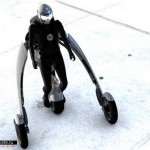Archive for Июнь, 2009
Pilot study of Lokomat versus manual-assisted treadmill training for locomotor recovery post-stroke
- Тип контента: Научная статья
- Номер документа: 6328
- Название документа: Pilot study of Lokomat versus manual-assisted treadmill training for locomotor recovery post-stroke
- Номер (DOI, IBSN, Патент): 10.1186/1743-0003-6-18
- Изобретатель/автор: Kelly P Westlake, Carolynn Patten
- Правопреемник/учебное заведение: University of California, San Francisco, University of Florida, Gainesville
- Дата публикации документа: 2009-06-12
- Страна опубликовавшая документ: США
- Язык документа: Английский
- Наименование изделия: Не заполнено
- Источник: Journal of NeuroEngineering and Rehabilitation
- Вложения: Да
- Аналитик: Глаголева Елена
 Background: While manually-assisted body-weight supported treadmill training (BWSTT) has revealed improved locomotor function in persons with post-stroke hemiparesis, outcomes are inconsistent and it is very labor intensive. Thus an alternate treatment app-roach is desirable. Objectives of this pilot study were to: 1) compare the efficacy of body-weight supported treadmill training (BWSTT) combined with the Lokomat robotic gait orthosis versus manually-assisted BWSTT for locomotor training post-stroke, and 2) assess effects of fast versus slow treadmill training speed. Methods: Sixteen volunteers with chronic hemiparetic gait (0.62 ± 0.30 m/s) post-stroke were randomly allocated to Lokomat (n = 8) or manual-BWSTT (n = 8) 3×/wk for 4 weeks. Groups were also stratified by fast (mean 0.92 ± 0.15 m/s) or slow (0.58 ± 0.12 m/s) training speeds. The primary outcomes were self-selected overground wal-king speed and paretic step length ratio. Secondary outcomes included: fast overground walking speed, 6-minute walk test, and a battery of clinical measures. Results: No significant differences in primary outcomes were revealed between Lokomat and manual groups as a result of training. However, within the Lokomat group, self-selected walk speed, paretic step length ratio, and four of the six secondary measures improved (p = 0.04–0.05, effect sizes = 0.19–0.60). Within the manual group, only balance scores improved (p = 0.02, effect size = 0.57). Group differences between fast and slow training groups were not revealed (p ≥ 0.28). Conclusion: Results suggest that Lokomat training may have advantages over manual-BWSTT following a modest intervention dose in chronic hemiparetic persons and further, that our training speeds produce similar gait improvements. Suggestions for a larger randomized controlled trial with optimal study parameters are provided.
Background: While manually-assisted body-weight supported treadmill training (BWSTT) has revealed improved locomotor function in persons with post-stroke hemiparesis, outcomes are inconsistent and it is very labor intensive. Thus an alternate treatment app-roach is desirable. Objectives of this pilot study were to: 1) compare the efficacy of body-weight supported treadmill training (BWSTT) combined with the Lokomat robotic gait orthosis versus manually-assisted BWSTT for locomotor training post-stroke, and 2) assess effects of fast versus slow treadmill training speed. Methods: Sixteen volunteers with chronic hemiparetic gait (0.62 ± 0.30 m/s) post-stroke were randomly allocated to Lokomat (n = 8) or manual-BWSTT (n = 8) 3×/wk for 4 weeks. Groups were also stratified by fast (mean 0.92 ± 0.15 m/s) or slow (0.58 ± 0.12 m/s) training speeds. The primary outcomes were self-selected overground wal-king speed and paretic step length ratio. Secondary outcomes included: fast overground walking speed, 6-minute walk test, and a battery of clinical measures. Results: No significant differences in primary outcomes were revealed between Lokomat and manual groups as a result of training. However, within the Lokomat group, self-selected walk speed, paretic step length ratio, and four of the six secondary measures improved (p = 0.04–0.05, effect sizes = 0.19–0.60). Within the manual group, only balance scores improved (p = 0.02, effect size = 0.57). Group differences between fast and slow training groups were not revealed (p ≥ 0.28). Conclusion: Results suggest that Lokomat training may have advantages over manual-BWSTT following a modest intervention dose in chronic hemiparetic persons and further, that our training speeds produce similar gait improvements. Suggestions for a larger randomized controlled trial with optimal study parameters are provided.
Категория: Научные статьи | Нет комментариев »
The exoskeletons are here
- Тип контента: Научная статья
- Номер документа: 6324
- Название документа: The exoskeletons are here
- Номер (DOI, IBSN, Патент): 10.1186/1743-0003-6-17
- Изобретатель/автор: Daniel P Ferris
- Правопреемник/учебное заведение: University of Michigan
- Дата публикации документа: 2009-06-09
- Страна опубликовавшая документ: США
- Язык документа: Английский
- Наименование изделия: Не заполнено
- Источник: Journal of NeuroEngineering and Rehabilitation
- Вложения: Да
- Аналитик: Глаголева Елена
 It is a fantastic time for the field of robo-tic exoskeletons. Recent advances in actuators, sensors, materials, batteries, and compu-ter processors have given new hope to crea-ting the exoskeletons of yesteryear’s science fiction. While the most common goal of an exoskeleton is to provide superhuman strength or endurance, scientists and engineers around the world are building exoskeletons with a wide range of diverse purposes. Exoskeletons can help patients with neurological disabilities improve their motor perfor-mance by providing task specific practice. Exoskeletons can help physiologists better understand how the human body works by pro-viding a novel experimental perturbation. Exoskeletons can even help power mobile phones, music players, and other portable elec-tronic devices by siphoning mechanical work performed during human locomotion. This special thematic series on robotic lower limb exoskeletons and orthoses includes eight pa-pers presenting novel contributions to the field. The collective message of the papers is that robotic exoskeletons will contribute in many ways to the future benefit of humankind, and that future is not that distant.
It is a fantastic time for the field of robo-tic exoskeletons. Recent advances in actuators, sensors, materials, batteries, and compu-ter processors have given new hope to crea-ting the exoskeletons of yesteryear’s science fiction. While the most common goal of an exoskeleton is to provide superhuman strength or endurance, scientists and engineers around the world are building exoskeletons with a wide range of diverse purposes. Exoskeletons can help patients with neurological disabilities improve their motor perfor-mance by providing task specific practice. Exoskeletons can help physiologists better understand how the human body works by pro-viding a novel experimental perturbation. Exoskeletons can even help power mobile phones, music players, and other portable elec-tronic devices by siphoning mechanical work performed during human locomotion. This special thematic series on robotic lower limb exoskeletons and orthoses includes eight pa-pers presenting novel contributions to the field. The collective message of the papers is that robotic exoskeletons will contribute in many ways to the future benefit of humankind, and that future is not that distant.
Категория: Научные статьи | 2 комментария »
Экзоскелет на колесах. Дизайн мотоцикла будущего.
- Тип контента: Новостная статья
- Номер документа: 4512
- Название документа: Экзоскелет на колесах. Дизайн мотоцикла будущего.
- Номер (DOI, IBSN, Патент): Не заполнено
- Изобретатель/автор: Не заполнено
- Правопреемник/учебное заведение: Не заполнено
- Дата публикации документа: 2009-06-05
- Страна опубликовавшая документ: Россия
- Язык документа: Русский
- Наименование изделия: Не заполнено
- Источник: http://www.novate.ru/blogs/050609/12191/
- Вложения: Не заполнено
- Аналитик: Helix
 Студент из Пасадены Джейк Лоняк предлагает концепт футуристического мотоцикла, представляющего собой экзоскелет на трех колесах. Причем, не просто экзоскелет, а с возможностью трансформации из одного состояния – прогулочного, в другое – скоростное.
Студент из Пасадены Джейк Лоняк предлагает концепт футуристического мотоцикла, представляющего собой экзоскелет на трех колесах. Причем, не просто экзоскелет, а с возможностью трансформации из одного состояния – прогулочного, в другое – скоростное.
Категория: Wearable Motorcycle | 2 комментария »
A Highly Backdrivable, Lightweight Knee Actuator for Investigating Gait in Stroke
- Тип контента: Научная статья
- Номер документа: 7752
- Название документа: A Highly Backdrivable, Lightweight Knee Actuator for Investigating Gait in Stroke
- Номер (DOI, IBSN, Патент): 10.1109/TRO.2009.2019788
- Изобретатель/автор: James S. Sulzer, Ronald A. Roiz, Michael A. Peshkin, James L. Patton
- Правопреемник/учебное заведение: Rehabilitation Institute of Chicago, Northwestern University, University of Illinois at Chicago
- Дата публикации документа: 2009-06-03
- Страна опубликовавшая документ: США
- Язык документа: Английский
- Наименование изделия: Не заполнено
- Источник: IEEE TRANSACTIONS ON ROBOTICS, VOL. 25, NO. 3, JUNE 2009
- Вложения: Да
- Аналитик: Глаголева Елена
 Many of those who survive a stroke develop a gait disability known as stiff-knee gait (SKG). Characterized by reduced knee flexion angle during swing, people with SKG walk with poor energy efficiency and asymmetry due to the compensatory mechanisms required to clear the foot. Previous modeling studies have shown that knee flexion activity directly before the foot leaves the ground, and this should result in improved knee flexion angle during swing. The goal of this research is to physically test this hypothesis using robotic intervention. We developed a device that is capable of assisting knee flexion torque before swing but feels imperceptible (transparent) for the rest of the gait cycle. This device uses sheathed Bowden cable to control the deflection of a compliant torsional spring in a configuration known as a Series Elastic Remote Knee Actuator (SERKA). In this investigation, we describe the design and evaluation of SERKA, which includes a pilot experiment on stroke subjects. SERKA could supply a substantial torque (12 N·m) in less than 20 ms, with a maximum torque of 41 N·m. The device resisted knee flexion imperceptibly when desired, at less than 1 N·m rms torque during normal gait. With the remote location of the actuator, the user experiences a mass of only 1.2 kg on the knee. We found that the device was capable of increasing both peak knee flexion angle and velocity during gait in stroke subjects. Thus, the SERKA is a valid experimental device that selectively alters knee kinetics and kinematics in gait after stroke.
Many of those who survive a stroke develop a gait disability known as stiff-knee gait (SKG). Characterized by reduced knee flexion angle during swing, people with SKG walk with poor energy efficiency and asymmetry due to the compensatory mechanisms required to clear the foot. Previous modeling studies have shown that knee flexion activity directly before the foot leaves the ground, and this should result in improved knee flexion angle during swing. The goal of this research is to physically test this hypothesis using robotic intervention. We developed a device that is capable of assisting knee flexion torque before swing but feels imperceptible (transparent) for the rest of the gait cycle. This device uses sheathed Bowden cable to control the deflection of a compliant torsional spring in a configuration known as a Series Elastic Remote Knee Actuator (SERKA). In this investigation, we describe the design and evaluation of SERKA, which includes a pilot experiment on stroke subjects. SERKA could supply a substantial torque (12 N·m) in less than 20 ms, with a maximum torque of 41 N·m. The device resisted knee flexion imperceptibly when desired, at less than 1 N·m rms torque during normal gait. With the remote location of the actuator, the user experiences a mass of only 1.2 kg on the knee. We found that the device was capable of increasing both peak knee flexion angle and velocity during gait in stroke subjects. Thus, the SERKA is a valid experimental device that selectively alters knee kinetics and kinematics in gait after stroke.
Категория: Научные статьи | Нет комментариев »
Using an electrohydraulic ankle foot orthosis to study modifications in feedforward control during locomotor adaptation to force fields applied in stance
- Тип контента: Научная статья
- Номер документа: 6320
- Название документа: Using an electrohydraulic ankle foot orthosis to study modifications in feedforward control during locomotor adaptation to force fields applied in stance
- Номер (DOI, IBSN, Патент): 10.1186/1743-0003-6-16
- Изобретатель/автор: Martin Noel, Laurent J Bouyer, Karine Fortin
- Правопреемник/учебное заведение: Université Laval, Canada
- Дата публикации документа: 2009-06-03
- Страна опубликовавшая документ: Канада
- Язык документа: Английский
- Наименование изделия: Не заполнено
- Источник: Journal of NeuroEngineering and Rehabilitation
- Вложения: Да
- Аналитик: Глаголева Елена
 Background: Adapting to external forces during walking has been proposed as a tool to improve locomotion after central nervous system injury. However, sensorimotor integration during walking varies according to the timing in the gait cycle, suggesting that adaptation may also depend on gait phases. In this study, an ElectroHydraulic AFO (EHO) was used to apply forces specifically during
Background: Adapting to external forces during walking has been proposed as a tool to improve locomotion after central nervous system injury. However, sensorimotor integration during walking varies according to the timing in the gait cycle, suggesting that adaptation may also depend on gait phases. In this study, an ElectroHydraulic AFO (EHO) was used to apply forces specifically during
mid-stance and push-off to evaluate if feedforward movement control can be adapted in these 2 gait phases. Methods: Eleven healthy subjects walked on a treadmill before (3 min), during (5 min) and after (5 min) exposure to 2 force fields applied by the EHO (mid-stance/push-off; ~10 Nm, towards dorsiflexion). To evaluate modifications in feedforward control, strides with no force field (‘catch strides’) were unexpectedly inserted during the force field walking period. Results: When initially exposed to a mid-stance force field (FF20%), subjects showed a significant increase in ankle dorsiflexion velocity. Catches applied early into the FF20% were similar to baseline (P > 0.99). Subjects gradually adapted by returning ankle velocity to baseline over ~50 strides. Catches applied thereafter showed decreased ankle velocity where the force field was normally applied, indicating the presence of feed-forward adaptation. When initially exposed to a push-off force field (FF50%), plantarflexion velocity was reduced in the zone of force field application. No adaptation occurred over the 5 min exposure. Catch strides kinematics remained similar to control at all times, suggesting no feedforward adaptation. As a control, force fields assisting plantarflexion (-3.5 to -9.5 Nm) were app-lied and increased ankle plantarflexion during push-off, confirming that the lack of kinematic changes during FF50% catch strides were not simply due to a large ankle impedance. Conclusion: Together these results show that ankle exoskeletons such as the EHO can be used to study phase-specific adaptive control of the ankle during locomotion. Our data suggest that, for short duration expo-sure, a feedforward modification in torque output occurs during mid-stance but not during push-off. These findings are important for the design of novel rehabilitation methods, as they suggest that the ability to use resistive force fields for training may depend on targeted gait phases.
Категория: Научные статьи | Нет комментариев »
Статистика
Категорий: 179
Статей всего: 2,003
По типу:
Видео: 36
Выдержка с форума: 1
Контактные данные: 12
Научная статья: 1388
Не заполнено: 5
Новостная статья: 317
Обзор технологии: 42
Патент: 219
Тех.подробности: 34
Тип: 1
Комментариев: 8,837
Изображений: 3,005
Подробней...
ТОР 10 аналитиков
-
Глаголева Елена - 591
Дмитрий Соловьев - 459
Helix - 218
Ридна Украина))) - 85
Наталья Черкасова - 81
max-orduan - 29
Елена Токай - 15
Роман Михайлов - 9
Мансур Жигануров - 4
Дуванова Татьяна - 3
Календарь
Авторизация
Ошибка в тексте?
Выдели её мышкой!
И нажми Ctrl+Enter